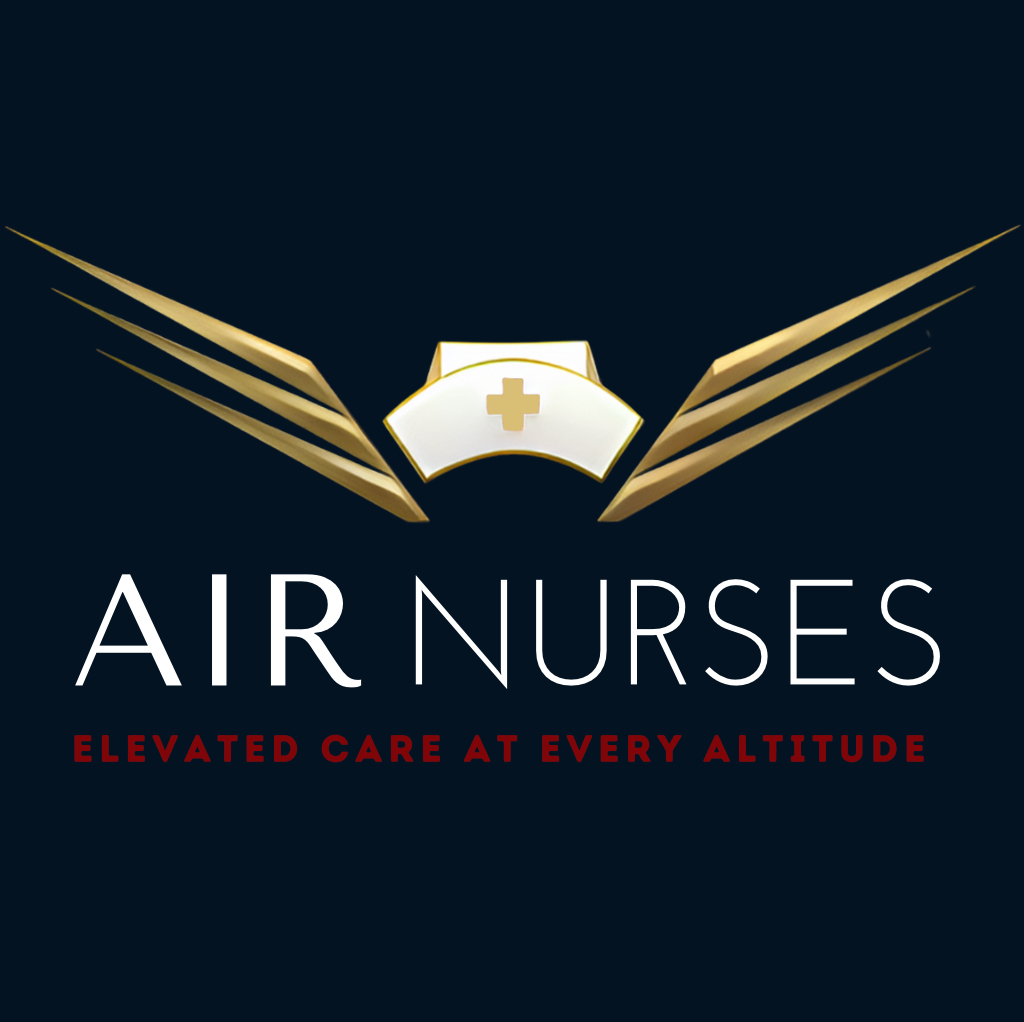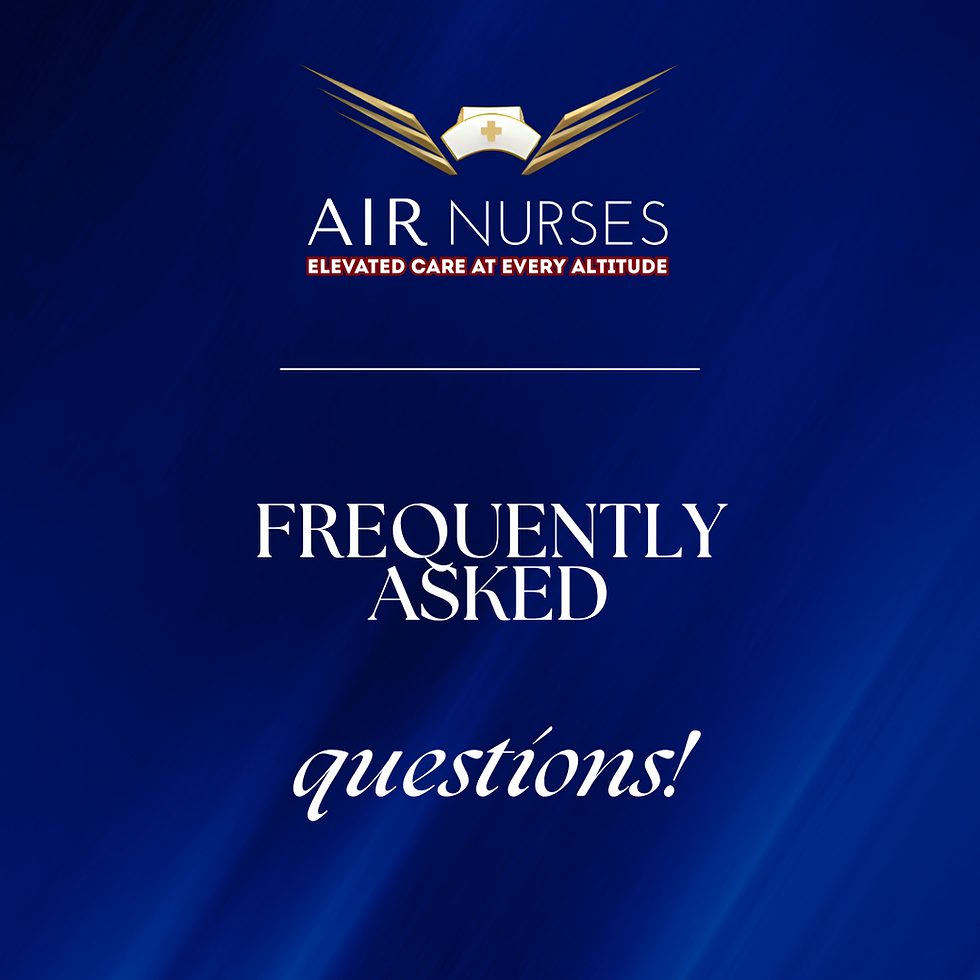Glossary of Terms
- Air Nurses

- Oct 20
- 3 min read
Air Nurses Glossary of Aviation & Medical Terms
When people first explore medical support in private aviation, the language can feel overwhelming. You’re suddenly dealing with two specialized industries — medicine and aviation — each with their own acronyms and shorthand. A simple word like escort might mean something very different in this context than it does elsewhere. This glossary is meant to translate that language into plain English. By understanding the terms, you’ll have more confidence in the decisions you make for yourself, your family, or your clients when arranging care in the air.
Aviation Terms
Altitude – The height of the aircraft above sea level, measured in feet. Higher altitudes can impact the way certain medications are processed by the body and how the body reacts. They can also mean lower oxygen levels, which can impact patients with certain conditions.
Cabin Pressure – The controlled air pressure inside the cabin, regulated so passengers experience the equivalent of a lower altitude (often 6,000–8,000 feet, even if the aircraft is flying at 40,000).
Crew Resource Management (CRM) – A training approach that teaches pilots, medical crew, and flight staff to communicate effectively, share information, and manage risks as a team.
FAA (Federal Aviation Administration) – The U.S. government body that oversees aviation safety, including rules for aircraft operations and medical equipment onboard.
FBO (Fixed Base Operator) – A private aviation terminal where services such as fueling, maintenance, and passenger boarding take place. Often the departure or arrival point for medical escort flights.
Jet Cabin – The pressurized passenger area of a private jet. Air Nurses adapt medical care for this unique environment.
Part 91 vs. Part 135 – FAA operating rules. Part 91 covers private, non-commercial flights; Part 135 covers charter flights. Many medical escort services operate under Part 135.
Turbulence – Air movement that causes bumps during flight. It can complicate patient care, requiring experienced flight nurses to anticipate and adjust.
Medical Terms
A&P (Assessment & Plan) – A structured approach clinicians use to evaluate patients and create a care plan. Used in-flight the same way as at a hospital bedside.
ALS (Advanced Life Support) – Higher-level emergency medical care involving advanced airway management, cardiac monitoring, and IV medications.
BLS (Basic Life Support) – Essential emergency interventions like CPR and oxygen, typically not involving advanced equipment or medications.
CFRN (Certified Flight Registered Nurse) – A credential that proves a nurse has advanced knowledge and expertise in flight and critical care transport. This certification is issued by the Board of Certification for Emergency Nursing (BCEN). This is the gold standard for flight nurses.
Critical Care – Medical care for patients with life-threatening conditions requiring close monitoring and advanced interventions.
Hypoxia – Low oxygen in the blood or tissues. A common risk at altitude if not carefully managed.
Oxygen Saturation (SpO₂) – A measurement of blood oxygen levels, usually monitored continuously during flight.
Portable Medical Equipment – Devices such as ventilators, infusion pumps, or cardiac monitors that are compact, FAA-approved, and safe for in-flight use.
Telemetry – Technology that allows real-time monitoring of vital signs (such as heart rhythm) in-flight.
Service-Specific Terms
Air Ambulance – A fully outfitted aircraft (often a jet or turboprop) configured like an ICU, with specialized equipment and staff for emergent transport.
Medical Escort – A healthcare professional (like a nurse or paramedic or EMT) who accompanies a stable patient on a non-emergency journey, often on a commercial flight, to provide care
Medical Companion – A lower-acuity option that provides non-medical support and supervision to patients, assisting with companionship, daily activities, and safety.
Stretcher Flight – A commercial aircraft modified with a stretcher setup for patients who must remain lying down. Requires airline and medical approvals.
Wheelchair Assistance – Support arranged through airlines or airports to help patients move between gates, terminals, or aircraft with minimal strain.
Professional & Safety Terms
Board of Certification for Emergency Nursing (BCEN) – The agency that administers the CFRN credential (as well as CEN, CPEN, TCRN, etc.).
Chain of Care – The coordinated transfer of responsibility from ground medical providers to flight nurses and back, ensuring continuity.
Fit-to-Fly Evaluation – A medical assessment performed to determine if a patient is stable and safe to travel by air.
Protocols – Pre-established medical guidelines that flight nurses follow under supervision of the physician medical director to ensure safe, standardized care in the air.
Scope of Practice – The legally defined boundaries of what a nurse, paramedic, or physician can do, based on training and licensure.
Most aviation glossaries focus on pilots, and most medical glossaries focus on hospitals. This one is built for the overlap — the unique space where medical care happens inside an aircraft. It’s designed for families, flight departments, and industry partners who want to understand not just what’s being said, but why it matters.




Comments